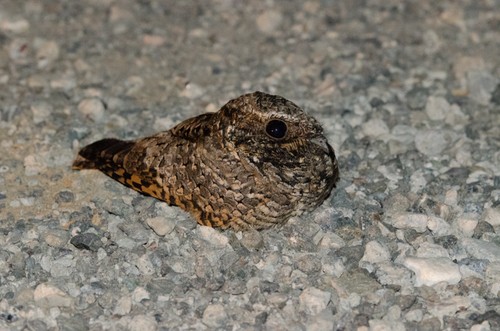Common Poorwill
A species of Common Poorwill Scientific name : Phalaenoptilus nuttallii Genus : Common Poorwill
Common Poorwill, A species of Common Poorwill
Botanical name: Phalaenoptilus nuttallii
Genus: Common Poorwill
Content
Description People often ask General Info
Description
The smallest American nightjar, the common Poorwill is found in semi-arid country, woodlands, and prairies, and it's the only bird known to hibernate for extended periods. The dull plumage enables the poorwill to camouflage very well, making it extremely inconspicuous. If a predator finds its nest, the female will perform a distraction display. This insectivorous bird is a nocturnal feeder.
Size
18 - 20 cm
Life Expectancy
3 years
Nest Placement
Ground
Clutch Size
2 eggs
Incubation Period
2 broods
Number of Broods
20 - 21 days
Nestling Period
20 - 23 days
Feeding Habits
Common Poorwill primarily consumes flying insects at night, favoring dusk and dawn for feeding. Perching low, they watch for prey and catch it mid-flight, mostly eating moths, beetles, grasshoppers, ants, and flies. They expel indigestible insect parts as pellets and can ingest insects up to 1.6 inches long.
Habitat
Common Poorwill primarily dwell in arid and semi-arid regions with sparse shrubbery, favoring environments such as rocky foothills, plateaus, and desert scrublands. They are commonly found at altitudes ranging from 1,000 to 7,000 feet, amongst vegetation like sagebrush, pinyon-juniper woodlands, and chaparral. Avoiding dense forest areas and thick grasslands, they opt for habitats that offer both open spaces and scattered woody cover. Common Poorwill are well-adapted to blend into their surroundings, often roosting inconspicuously on the ground or hidden among rocks.
Nest Behavior
Common Poorwill engages in minimal nest preparation, simply scraping a spot on the ground. Egg-laying occurs without a built structure, and parental care involves incubation and camouflage to protect eggs and young in their ground setting.
Nest Characteristics
Common Poorwill does not construct a traditional nest; rather, it chooses to lay its eggs directly on the ground, typically in sandy or stony areas, with occasional leaf litter or pine needles, often beside protective cover like shrubs, cacti, or rocks.
Dite type
Insectivorous
People often ask
General Info
Feeding Habits
Bird food type
Behavior
Common Poorwill are notable for basking on south-facing slopes, a behavior that helps them regulate their body temperature. These birds have a proclivity for creating nests in such warm locations. Their roosting habits during the daytime typically involve seeking shade beneath bushes, with individuals showing loyalty to specific favorite spots. Occasionally, family groups may roost in concert. In addition to dust-bathing, which is instrumental for parasite control, common Poorwill engage in meticulous preening. This maintenance often starts with a distinctive swaying motion. When feeling threatened, common Poorwill exhibit a unique defensive behavior, which includes gaping their large mouth, extending their wings, puffing up their feathers, and emitting a hissing sound to deter potential predators.
Species Status
Not globally threatened.
Scientific Classification
Phylum
Chordates Class
Birds Order
Nightjars and Relatives Family
Nightjars and nighthawks Genus
Common Poorwill Species
Common Poorwill 